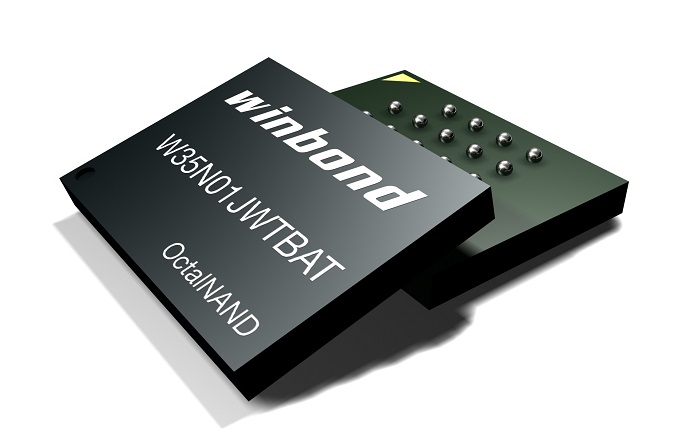By Gina Roos, editor-in-chief
Winbond Electronics Corp. has released a new high-speed OctalNAND flash memory device that makes high-density serial NAND flash a low-cost alternative to Octal NOR flash. The OctalNAND flash, claimed as the industry’s first x8 Octal interface for NAND flash, enables automotive and industrial manufacturers to provide code storage in high density without paying a premium and any special hardware change for NOR flash, said the company.
The first Winbond product to include the new interface, the 1-Gbit W35N01JW, offers a maximum continuous read throughput of 240 Mbytes/s, which is 3× faster than the previous high-performance W25N-JW QspiNAND flash family. The single-die W35N01JW is also 50% faster than Winbond’s W72N-JW family of Dual QspiNAND devices, which have dual dies in a single package and a more complex x2/x4/x8 I/O architecture.

Winbond said that it developed the OctalNAND flash because automotive and industrial OEMs are reaching the limits of NOR flash technology’s ability to scale cost-effectively in industry-standard packages. In automotive applications, including graphics displays and advanced driver-assistance systems (ADAS) in which the boot code size is often higher than 512 Mbits, NOR flash is reaching its limitations in scale.
“Customers have traditionally used NOR flash for code storage because it is highly reliable and its fast-read throughput supports fast boot performance,” said Winbond. “At densities above 512 Mbits, however, NOR flash scales poorly and die size and cost become excessive.”
The company also noted that NAND flash technology scales well, but conventional NAND flash has been too slow for functions such as shadowing boot code to DRAM.
The W35N-JW OctalNAND flash is manufactured in Winbond’s 46-nm single-level cell (SLC) NAND fabrication process. It is specified to perform more than 100,000 program/erase cycles, providing a high level of reliability required in mission-critical automotive and industrial applications.
Specifications include operation at up to 166 MHz in single-data-rate mode and up to 120 MHz in double-data-rate mode, a supply voltage of 1.7 V to 1.95 V, and a maximum write speed of 16.9 Mbytes/s. Data integrity is maintained by the on-chip 1-bit error correction code (ECC), which helps optimize the chip’s bad block management.
The OctalNAND flash offers partial compatibility with Octal NOR flash, which makes it easier to replace NOR flash in existing designs. Housed in an industry-standard 8 × 6-mm BGA package, the device is footprint-compatible with serial NOR flash products and is fully pin-compatible with Xccela flash and OctaFlash NOR products on the market today.
In addition, the W35N-JW parts include a reset pin, which is compatible with the pin-out of equivalent NOR flash devices. This enables customers to retain existing serial NAND software for triggering a system reboot, said the company.
Advertisement
Learn more about Electronic Products Magazine





